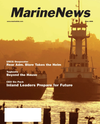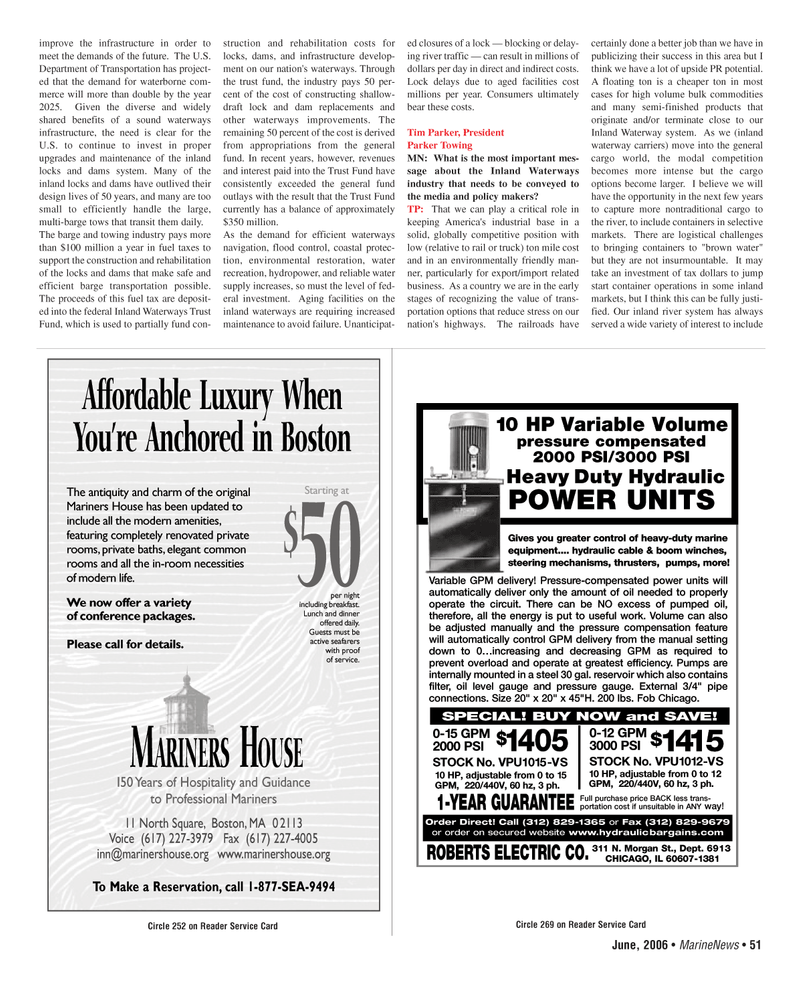
Page 51: of Marine News Magazine (June 2006)
Fourth Annual "Geo Six Pack"
Read this page in Pdf, Flash or Html5 edition of June 2006 Marine News Magazine
June, 2006 • MarineNews 51 improve the infrastructure in order to meet the demands of the future. The U.S.
Department of Transportation has project- ed that the demand for waterborne com- merce will more than double by the year 2025. Given the diverse and widely shared benefits of a sound waterways infrastructure, the need is clear for the
U.S. to continue to invest in proper upgrades and maintenance of the inland locks and dams system. Many of the inland locks and dams have outlived their design lives of 50 years, and many are too small to efficiently handle the large, multi-barge tows that transit them daily.
The barge and towing industry pays more than $100 million a year in fuel taxes to support the construction and rehabilitation of the locks and dams that make safe and efficient barge transportation possible.
The proceeds of this fuel tax are deposit- ed into the federal Inland Waterways Trust
Fund, which is used to partially fund con- struction and rehabilitation costs for locks, dams, and infrastructure develop- ment on our nation's waterways. Through the trust fund, the industry pays 50 per- cent of the cost of constructing shallow- draft lock and dam replacements and other waterways improvements. The remaining 50 percent of the cost is derived from appropriations from the general fund. In recent years, however, revenues and interest paid into the Trust Fund have consistently exceeded the general fund outlays with the result that the Trust Fund currently has a balance of approximately $350 million.
As the demand for efficient waterways navigation, flood control, coastal protec- tion, environmental restoration, water recreation, hydropower, and reliable water supply increases, so must the level of fed- eral investment. Aging facilities on the inland waterways are requiring increased maintenance to avoid failure. Unanticipat- ed closures of a lock — blocking or delay- ing river traffic — can result in millions of dollars per day in direct and indirect costs.
Lock delays due to aged facilities cost millions per year. Consumers ultimately bear these costs.
Tim Parker, President
Parker Towing
MN: What is the most important mes- sage about the Inland Waterways industry that needs to be conveyed to the media and policy makers?
TP: That we can play a critical role in keeping America's industrial base in a solid, globally competitive position with low (relative to rail or truck) ton mile cost and in an environmentally friendly man- ner, particularly for export/import related business. As a country we are in the early stages of recognizing the value of trans- portation options that reduce stress on our nation's highways. The railroads have certainly done a better job than we have in publicizing their success in this area but I think we have a lot of upside PR potential.
A floating ton is a cheaper ton in most cases for high volume bulk commodities and many semi-finished products that originate and/or terminate close to our
Inland Waterway system. As we (inland waterway carriers) move into the general cargo world, the modal competition becomes more intense but the cargo options become larger. I believe we will have the opportunity in the next few years to capture more nontraditional cargo to the river, to include containers in selective markets. There are logistical challenges to bringing containers to "brown water" but they are not insurmountable. It may take an investment of tax dollars to jump start container operations in some inland markets, but I think this can be fully justi- fied. Our inland river system has always served a wide variety of interest to include 10 HP, adjustable from 0 to 15
GPM, 220/440V, 60 hz, 3 ph. 10 HP, adjustable from 0 to 12
GPM, 220/440V, 60 hz, 3 ph.
Variable GPM delivery! Pressure-compensated power units will automatically deliver only the amount of oil needed to properly operate the circuit. There can be NO excess of pumped oil, therefore, all the energy is put to useful work. Volume can also be adjusted manually and the pressure compensation feature will automatically control GPM delivery from the manual setting down to 0…increasing and decreasing GPM as required to prevent overload and operate at greatest efficiency. Pumps are internally mounted in a steel 30 gal. reservoir which also contains filter, oil level gauge and pressure gauge. External 3/4" pipe connections. Size 20" x 20" x 45"H. 200 lbs. Fob Chicago.
Gives you greater control of heavy-duty marine equipment.... hydraulic cable & boom winches, steering mechanisms, thrusters, pumps, more! 10 HP Variable Volume pressure compensated 2000 PSI/3000 PSI
Heavy Duty Hydraulic
POWER UNITS
SPECIAL! BUY NOW and SAVE! 0-15 GPM 2000 PSI
STOCK No. VPU1015-VS $ 1405 0-12 GPM 3000 PSI
STOCK No. VPU1012-VS $ 1415 311 N. Morgan St., Dept. 6913
CHICAGO, IL 60607-1381 1-YEAR GUARANTEE
Full purchase price BACK less trans- portation cost if unsuitable in ANY way!
Order Direct! Call (312) 829-1365 or Fax (312) 829-9679 or order on secured website www.hydraulicbargains.com
ROBERTS ELECTRIC CO.
Circle 269 on Reader Service Card
Circle 252 on Reader Service Card
To Make a Reservation, call 1-877-SEA-9494 11 North Square, Boston, MA 0 2113
Voice (617) 227-3979 Fax (617) 227-4005 [email protected] www.marinershouse.org
Starting at $ 50 per night including breakfast.
Lunch and dinner offered daily. Guests must be active seafarers with proof of service.
Affordable Luxury When
You’re Anchored in Boston
The antiquity and charm of the original
Mariners House has been updated to include all the modern amenities, featuring completely renovated private rooms, private baths, elegant common rooms and all the in-room necessities of modern life.
We now offer a variety of conference packages.
Please call for details. 150 Years of Hospitality and Guidance to Professional Mariners
MARINERS HOUSE
JUNE MN2006 7(49-56).qxd 6/2/2006 4:28 PM Page 51

 50
50

 52
52
